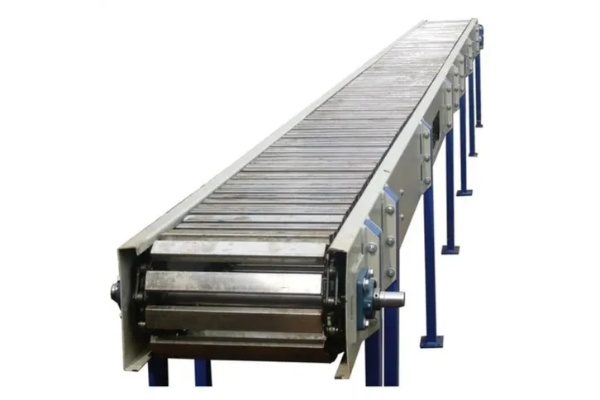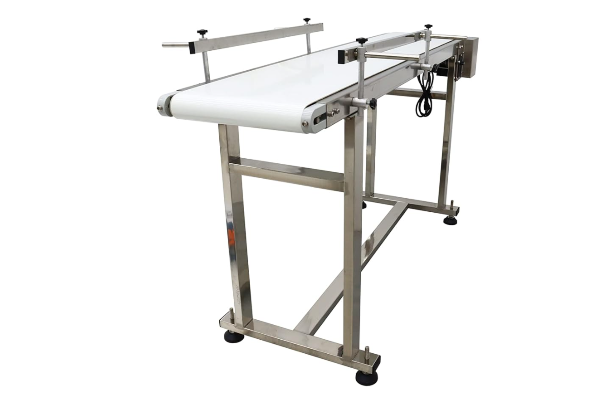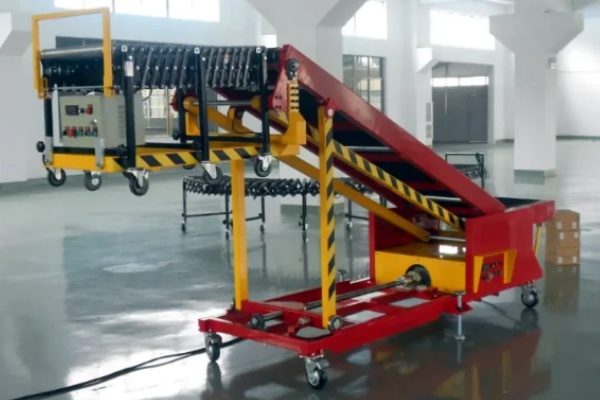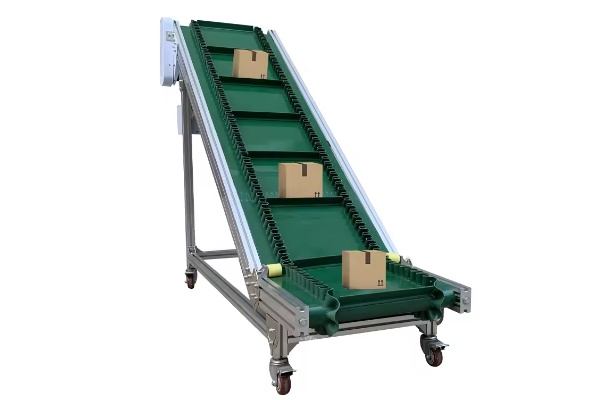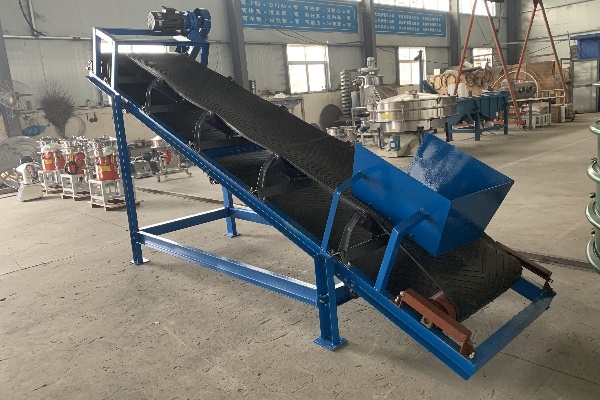
Coal rubber belt conveyor
The price of a coal rubber belt conveyor varies from $130 to $6,500, depending on a variety of factors including conveying length, bandwidth, and customization requirements.
Voltage: 220V, 380V
Power: 1kW, 2KW, 3KW, 5KW
Productivity: 500 liters/hour
Belt material: PVC PU rubber/steel rubber
Belt width: 400/500/1500mm/customized
Length: 1-100m/customized
What is Coal rubber belt conveyor?
Coal rubber belt conveyor is a kind of mechanical equipment widely used in the field of bulk material transportation, especially in the coal industry. Its basic function is to continuously convey materials such as coal blocks and coal powder. It realizes the transfer of materials from one point to another through the endless rubber conveyor belt driven by the drive device. According to the actual application requirements, the bandwidth specifications of this type of conveyor are various, and the common ones are 500 mm, 650 mm, 1000 mm, 1200 mm and larger sizes. The size of the bandwidth directly affects its conveying capacity. The conveying capacity of the coal rubber belt conveyor depends on the bandwidth, belt speed and the bulk density of the conveyed coal. The conveyor with a bandwidth of 800 mm and a belt speed of 2.0 m/s can reach hundreds of tons per hour when conveying coal with a bulk density of 0.8 tons/cubic meter. In addition, the length of the conveyor depends on the actual layout and can range from tens of meters to thousands of meters.
What are the types of coal rubber belt conveyor?
Coal rubber belt conveyor is a common equipment in coal transportation. According to its specific use and structural characteristics, it can be further divided into multiple types. The following are several common types divided according to function and structural characteristics:
Inclined belt conveyorInclined belt conveyor is mainly used to transport coal from a lower height to a higher height, or vice versa. It overcomes the limitations of horizontal transportation and can use the friction between the conveyor belt and the coal and auxiliary structures such as sidewalls and partitions to realize the upward or downward transportation of materials.
Features: The conveyor belt is arranged at a certain inclination angle. The size of the inclination angle depends on the material properties of the transported coal (such as particle size, moisture content, friction coefficient, etc.) and the type of conveyor belt (whether there are sidewalls, partitions, etc.).
Mobile belt conveyorMobile belt conveyor is a conveying equipment that can move itself. It is usually equipped with a wheeled or crawler chassis at the bottom, and the working position can be changed as needed.
Features: compact structure, strong maneuverability, and easy transfer. It is usually composed of a conveyor body, a walking mechanism, a lifting mechanism (some models) and an electrical control system.
Skirt-type belt conveyorSkirt-type belt conveyor is usually based on ordinary flat belt conveyor, with fixed or flexible "skirts" or guide troughs installed on both sides of the conveyor belt to prevent materials from spilling during transportation.
Features: Side plates or flexible rubber plates are set on both sides of the conveyor belt at a certain height above the conveying surface to form a closed trough-shaped space. These skirts are usually more obvious at the drop point and transition section to ensure material stability.

What are the advantages of coal rubber belt conveyor?
Coal rubber belt conveyor has strong conveying capacity and continuity, and can continuously handle large amounts of coal from hundreds to thousands of tons per hour, significantly improving production efficiency. Secondly, its long-distance conveying capacity and adaptability to complex terrain enable it to be flexibly applied to various line arrangements underground and on the ground in coal mines. In addition, the smooth operation of the rubber belt helps to reduce the breakage of coal and maintain the quality of coal. Especially in long-distance and large-volume transportation, there is often a long distance and complex terrain between the mining area of the coal mine and the ground processing plant. The rubber belt conveyor can flexibly arrange the conveying line to achieve long-distance coal transportation. Whether it is underground tunnels or on the ground, it can be laid as needed. Moreover, the rubber belt has a certain elasticity, and it runs relatively smoothly during the transportation of coal, which can reduce the rolling and collision of coal, thereby reducing the breakage rate of coal. The structure of the rubber belt conveyor is relatively simple, and the maintenance and replacement of the main components are relatively convenient. For coal mines, simple maintenance helps to reduce downtime and ensure the continuity of coal production. It is especially worth emphasizing its safety. By adopting flame-retardant conveyor belts, the risk of accidents in flammable and explosive coal mine environments is effectively reduced.
Basic parameters of coal rubber belt conveyor
|
Belt width (mm) |
Conveying length(m) Power(kw) |
Conveying speed (m/s) |
Conveying amount (t/h) |
||
| B400 | ≤10 | 12-15 | 5-30 | 1.25-2.0 | 30-60 |
| 3 | 3-4 | 4-7.5 | |||
| B500 | ≤10 | 12-15 | 15-30 | 1.25-2.0 | 40-80 |
| 3 | 4-5.5 | 5.5-7.5 | |||
| B650 | ≤10 | 12-15 | 15-30 | 1.25-2.0 | 80-120 |
| 4 | 7.5 | 7.5-11 | |||
| B800 | ≤10 | 12-15 | 15-30 | 1.25-2.0 | 120-200 |
| 4 | 7.5 | 7.5-15 | |||
| B1000 | ≤10 | 10-20 | 20-40 | 1.25-2.0 | 200-320 |
| 5.5 | 7.5-11 | 11-22 | |||
| B1200 | ≤10 | 10-20 | 20-40 | 1.25-2.0 | 290-480 |
| 7.5 | 7.5-15 | 15-30 | |||
| B1400 | ≤10 | 10-20 | <20-40 | 1.25-2.0 | 400-680 |
| 11 | 15-22 | 22-45 | |||
| B1600 | ≤10 | 10-20 | <20-50 | 1.25-2.0 | 600-1080 |
| 15 | 22-30 | 30-75 | |||
| B1800 | ≤10 | 10-20 | <20-50 | 1.0-2.0 | 200-1500 |
| 18.5 | 30-45 | 45-110 | |||
| B2000 | ≤10 | 10-20 | <20-40 | 1.0-2.0 | 1000-2000 |
| 22 | 45-55 | 55-132 | |||
| B2400 | ≤10 | 10-20 | <20-40 | 1.0-2.0 | 1500-3000 |
What is the structure of Coal rubber belt conveyor?
Coal rubber belt conveyor is mainly composed of the following parts: the conveyor belt as the main load-bearing and traction component, usually composed of multiple layers of rubber and fabric or steel wire rope core, its structure includes a cover layer to protect the core and the material, a core to provide strength, and a buffer layer to improve impact resistance, which has certain wear resistance and tear resistance for coal transportation; the driving device that provides operating power, usually includes an electric motor, a reducer, a coupling and a driving roller, which is driven by the friction between the driving roller and the conveyor belt, and can be driven by a single roller or multiple rollers according to the power and layout; the roller used to support, turn and drive the conveyor belt, including the roller with high friction on the surface of the power supply. The driving rollers for wiping materials, the smooth redirecting rollers for changing direction or providing tension, and the tensioning rollers for adjusting the tension of the conveyor belt; the rollers that support the conveyor belt and materials and reduce the running resistance are divided into grooved load-bearing rollers that support the materials in the upper belt section, straight roller return rollers that support the lower belt section, and self-aligning rollers that automatically correct the deviation; the tensioning device that provides the required tension of the conveyor belt, the common types are spiral, vertical hammer and hydraulic, etc., to ensure friction and limit sag; the cleaning device that removes adhered materials and prevents carryback and wear, including scraper type, roller type and brush type; and the frame that serves as the skeleton to support various components, usually welded from steel sections.
What are the applications of Coal rubber belt conveyor?
Inside the coal mine, the raw coal mined underground is first continuously transported to the main transportation tunnel through a belt conveyor, which improves the efficiency of coal out of the mine; and the raw coal lifted to the ground is also sent to the coal preparation plant for processing or directly stacked in the coal storage yard by the ground belt conveyor system. The various process links inside the coal preparation plant, such as crushing, screening, washing, etc., are also inseparable from the belt conveyor for the transportation of different coal products and gangue. In terms of external transportation of coal, long-distance and large-volume belt conveyor systems are often used to transport coal directly from mining areas or coal storage yards to power plants, realizing short-distance transportation; at port terminals, belt conveyors undertake the loading and unloading and transfer tasks of coal, connecting land transportation and water transportation. Finally, in the process of coal processing, the coal preparation plant uses belt conveyors to connect various process units to form a continuous material flow. In summary, Coal rubber belt conveyor runs through the entire process of coal mining, processing to end users (such as power plants and ports).
Coal rubber belt conveyor is used in current coal mining, processing, and transportation due to its ability to continuously convey bulk materials, as well as its customizable bandwidth, length, and conveying capacity. Its operation depends on the coordinated work of various components, including the drive device that provides power, the conveyor belt that carries the material, and the supporting and guiding rollers and rollers. The specific technical parameters and configuration of the conveyor will also be adjusted for different applications and material characteristics. Therefore, when selecting and using the coal rubber belt conveyor, it is necessary to make comprehensive considerations based on the actual transportation needs and working conditions to ensure its stable operation and meet the requirements of material transportation.
